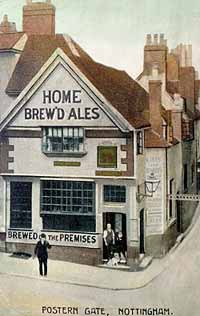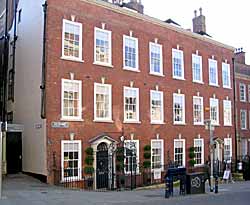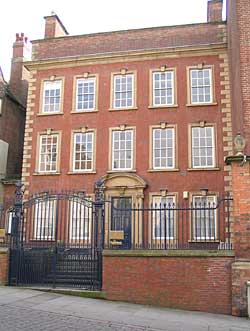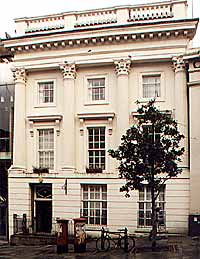< Previous | Contents | Next >
Low Pavement

The Old Postern Gate pub in the early 20th century.
On the northern side of Drury Hill stood until quite recently a picturesque old inn which was called "The Old Postern Gate" and which occupied the site of the postern which we have already considered. Although a half timbered structure this inn was not as old as it looked. As a matter of fact it was built just before the Civil War and was then known as the "Bull's Head." By 1812 it had come to be called the "Golden Fleece" and I cannot trace when this name was changed to its more modern one of "The Old Postern Gate." It has completely disappeared together with the foundations of the guard-room under it but careful notes and drawings of this relic of the past were taken by Mr. Dobson.
On the other side of Drury Hill, No. 26, Low Pavement, is a beautiful house now divided up into offices which has a very interesting history. It stands upon the site of the old Vault Hall which at one time was the residence of the Plumtree family, and under it are very extensive rock cellars which in times past were used for the storage of wool and which during the terrible times of the religious persecutions in Stuart times were used as a secret meeting place for the body of earnest Christians who afterwards founded the High Pavement Chapel. In 1645, three years after Charles had raised his standard at Nottingham Castle, it was sold by Richard and John Martin to Alderman Drury for £103, probably worth about £1,000 now-a-days. His grandson very likely did some building here and he re-sold the house in 1733 to Mr. Gawthorne for £500. Mr. Gawthorne enlarged and partially re-built the house leaving it pretty much in its present condition.

Number 26, Low Pavement (A Nicholson, 2004).
Its details are really beautiful, particularly its doorways, while the crown glass in the windows presents a most beautiful iridescent effect. This crown glass is very interesting in its manufacture. Before the days of plate glass and modern methods the way that sheets of glass were obtained for windows was to heat the component parts of glass to a sticky mass by means of heat and then to plunge a rod into this mass and stir it about until a blob had attached itself to the end. The rod was then spun between the hands, just as one dries a mop, and centrifugal pressure caused the sticky glass to spread itself out into a more or less thin sheet. This was pressed against a flat surface, such as a stone, and the rod withdrawn and the whole was left to cool. When cool as large pieces of glass as were possible were cut from the roughly circular sheet of glass and the blob in the centre where the rod had been withdrawn was utilized for glazing out-houses and unimportant windows. These blobs, or bottle glass as we call them, are now much sought after. The waste pieces round the edge with their curious curved outer edges were of little use until somebody thought of making fan-lights, those delightful semi-circular windows above doorways. These fan-lights were filled with all sorts of elaborate and beautiful tracery and the openings in this tracery were glazed with these waste pieces. A great deal of pleasure can be found in Nottingham by walking about the older streets and noticing the great variety of the tracery of these ancient fan-lights, many of which are exceedingly beautiful.
The inside of this house is as beautiful as the outside, and its staircase and fireplaces and fittings are excellent examples of what the 18th century architects could design when once the way had been pointed out to them by the brothers Adam. The ironwork which fronts Low Pavement is one of the finest runs of ironwork left to us in Nottingham and the main gateway is interesting in that upon it there is a small oval which bears the only iron coat of arms in Nottingham. It is the Gawthorne coat of arms impaled with that of Austin and is well worth studying. A little, way down Drury Lane will be seen lead rain water heads with the initials F.G. and the Gawthorne crest which is of course different from the Gawthorne coat of arms.

Willoughby House (A Nicholson, 2004).
The next house is Willoughby House, a perfectly magnificent structure built by the Hon. Rothwell Willoughby brother of Lord Middleton between the years 1730 and 1740. The Hon. Rothwell Willoughby was a bachelor when he built this beautiful house, and it is interesting to remember that he kept a pack of hounds in Nottingham for the benefit of all and sundry. I have no idea where he kennelled them, but should imagine somewhere in Broad Marsh. Underneath this house are extensive cellars cut out of the solid rock and described by Deering as the finest in the town. The roof of each chamber is supported by a central shaft and the workmanship is clear and clean cut. Two main features stand out in this house the first being the doorway with its broken pediment and magnificent Ionic columns and the second being the parapet which surrounds the roof. At the time that this house was built the view from the roof was regarded as a great asset and regular walks covered with lead were made round the edge of the roof, easy access to which was arranged by means of internal stairways. To prevent accidents, parapets, such as this one at Willoughby House were set up and the good folk of the 18th century and even earlier used to spend a good deal of their leisure on these "leads" as they called them. Readers of Pepy's Diary will find references to evenings spent upon the leads engaged in singing and talking. The modern ironwork in front of Willoughby House is well worthy of attention. It is excellently designed and carried out in the true spirit of the old ironworkers.
The whole of this side of Low Pavement merits careful consideration as behind the modern fronts there still remain beautiful old houses, glimpses of whose stately bay windows and derelict gardens can be obtained by going up the various passages leading off Low Pavement. But above all, the beautiful entrance and the Venetian windows, three windows grouped together with a segmental arch over the middle one, presented by No. 18 is probably the best. I cannot give any account of the history of this house, but its architecture is beautiful. Of the north side there are one or two interesting things to relate. No. 5 was the second stuccoed house in Nottingham, Plumtree House being the first. It was built by a Mr. Allsop, Solicitor, in 1808 and was looked upon as a very fine construction.
 Assembly Rooms, Low Pavement (A Nicholson,
2001).
Assembly Rooms, Low Pavement (A Nicholson,
2001).No. 7, with its four fluted Corinthian columns is all that is left of the old Assembly Rooms of Nottingham. As early as 1739 there were monthly Assemblies held in Nottingham for cards and dancing, but these Assemblies became more frequent later on when this hall was built. The Assemblies held within it were called the "Ladies' Assembly" and were intended only for the gentry. There was another Assembly called the "Tradesmen's Assembly" which met every third Tuesday in Thurland Hall.
In 1807 the hall was repaired and enlarged at a cost of £1,545 and the building was then so handsome that it was enacted that henceforward no concerts should be held within it! The meetings were presided over by a mistress of ceremonies who was called a "Queen" probably in imitation of the King of Bath, Beau Nash. I am sorry that I cannot give the rules governing this select assembly, but a similar assembly in Derby in 1747 adopted these rules:—
- No attorney's clerk shall be admitted.
- No shop-keeper or any of his or her family shall be admitted except Mr. Francis.
- No lady shall be allowed to dance in a long white apron.
- All young ladies in mantuas shall pay—2/6.
- No Miss in a coat shall dance without the leave of the lady of the assembly.
- Whoever shall transgress these rules shall be turned out of the assembly.
It must have been a strange and pokey social life in Nottingham in the early days of the 19th century and it is interesting that we have an account of it from the cynical pen of G. M. Woodward, who in 1807 published his "Eccentric Excursions." The following extract from which book will show us very clearly the house that Woodward built "Nottingham is famed for its eminent exposure to rough winds and rich production of old maids." "As to the old maids of Nottingham they are in many respects a very harmless race of beings, remarkably partial to stiff stays, umbrellas and striped great coats and in general making a tolerably old-fashioned appearance." "Cards engrossed the time of two thirds of the inhabitants and is the subject of their early thoughts and midnight slumbers."
The Savings Bank just above the old Assembly Rooms was originally built in 1838, but has been modernised of late years.
